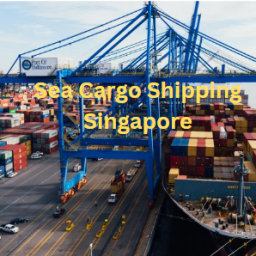
Imagine you’re sitting at home, scrolling through an online store, and with just a few clicks, you’ve bought something from halfway around the globe. It could be anything—clothes, gadgets, or furniture. But have you ever stopped to think about how that product made its way to your doorstep? While rapid delivery options like air freight might come to mind, the real hero behind most of these transactions is sea freight forwarders in Singapore.
Whether it’s bulk orders, international shipments, or helping businesses scale up, it connects markets, people, and products across oceans. In this blog, we’ll examine how this humble transportation giant is the backbone of e-commerce and large-scale logistics, making it possible for goods to be delivered efficiently and affordably.
Why Sea Freight Matters in E-Commerce
E-commerce carries significant stakes. Online retailers are constantly looking for ways to lower costs, increase efficiency, and deliver products to customers as quickly as possible. Here are several reasons why it is essential to e-commerce:
1. Cost-Effectiveness
Sea freight is cheaper than air freight. Shipping large quantities of products allows businesses to take advantage of economies of scale, reducing the cost per unit. Providing large-scale logistics services necessitates the shipping of hundreds or even thousands of containers, resulting in a significant cost difference.
While air freight might get your products to their destination in days, sea freight can take several weeks. But if you are shipping large volumes, the reduced shipping cost per unit is often worth the extra time.
2. Scalability for Large Orders
E-commerce businesses that handle bulk orders or large inventories rely on sea freight to scale their operations. Whether a small startup is growing into a multinational or a large corporation is expanding its product line, ocean freight can handle large quantities of goods in one trip.
Large containers are perfect for bulk shipments, which means businesses can store and transport more products at a lower cost.
3. Global Reach
One of the biggest advantages is its global reach. The oceans connect nearly every part of the world, and sea freight services can transport goods from virtually any port to any other port worldwide. This makes it an indispensable option for e-commerce companies looking to expand into new international markets.
Whether you are exporting handmade products or sourcing components, it gives you access to the global supply chain, bridging distances that air or land transportation can’t.
4. Sustainability
Sustainability is becoming increasingly important. Sea freight stands out as a more eco-friendly alternative to air freight. While ships do burn fuel, their emissions per ton of cargo are much lower than those of aeroplanes. Due to the massive capacity of cargo ships, shipping by ocean is inherently more energy-efficient.
Additionally, by depending more on it, businesses can reduce the pressure on air transport. It is helping to transform global supply chains and minimize their environmental footprint.
How Does It Support Large-Scale Logistics?
Sea freight is integral to the efficiency of large-scale logistics services. Let’s examine how it supports these huge operations.
1. Efficiency in Bulk Transport
One key advantage of sea freight in large-scale logistics is its ability to handle bulk goods. Ships can carry massive quantities of raw materials, manufactured products, and containers with thousands of items inside. This allows for the consolidation of shipments from different suppliers into one large consignment, saving money and minimizing the number of trips required.
2. Flexibility in Cargo Options
It provides a variety of cargo options, enabling companies to select their shipments according to the type of product they are transporting. For example, perishable goods can be transported in refrigerated containers, known as reefer containers. They ensure goods reach their destination fresh. Others might be shipped in standard containers or even in breakbulk shipments.
3. Linking Production and Distribution Centers
Production and distribution centers are spread out across different continents. Manufacturers may source raw materials from one part of the world, produce goods in another, and then distribute those goods globally. Sea freight links all these different points in the supply chain. By doing so, goods flow smoothly from production to consumer markets.
4. Reducing Inventory Costs
Shipping by sea manages inventory costs. Large-scale logistics involve extensive warehouses and distribution centers that require products to be shipped on time to meet demand. It allows businesses to move large quantities of products at once, reducing the need to store huge stock in multiple locations. Maintaining optimal inventory levels helps manage warehouse space while keeping costs down.
The Role of Technology in Sea Freight for E-Commerce
Technology is enhancing ocean freight. Let’s see how it can address the hurdles companies face:
- Technology now allows businesses and customers to track their shipments in real-time, providing full visibility of the delivery process. This transparency helps manage customer expectations and reduces the anxiety of waiting for products.
- With improvements in navigation technology, ships can now take the most efficient routes, reducing the time spent at sea and helping to meet estimated delivery windows more accurately.
- Many ports are now adopting automation, which speeds up the loading and unloading of goods. Automated cranes, robotics, and AI-driven systems help improve port operations, reducing bottlenecks and ship waiting times.
- One key complexity of sea freight is the longer shipping times compared to air freight. However, technology is helping improve shipping efficiency through optimized route planning.
- Port congestion leads to delays. With real-time data and better forecasting tools, businesses can now plan for these issues in advance and adjust their shipping schedules accordingly.
- Unpredictable weather conditions can also impact sea freight, leading to delays or rerouted shipments. With advanced systems, shipping companies can better anticipate adverse weather and adjust routes or schedules to avoid delays.
Sea Freight: The Anchor of Global E-Commerce Growth!
As e-commerce continues to grow, the reliance on sea freight will only increase. Despite its slower transit times, it offers unmatched value for large shipments and long-distance transportation. By understanding its benefits and overcoming its complexities, businesses can continue to harness its potential to support their global logistics efforts and keep their e-commerce engines running smoothly.
Choosing the right logistics services in singapore is important for success. Faith Logistics stands out as the best sea freight forwarder in Singapore, offering expert solutions. With our extensive network, robust services, and commitment to customer satisfaction, we are well-positioned to help companies navigate the complexities of sea freight.
Contact Faith Logistics now to learn how we can enhance your shipping and support your growth!


